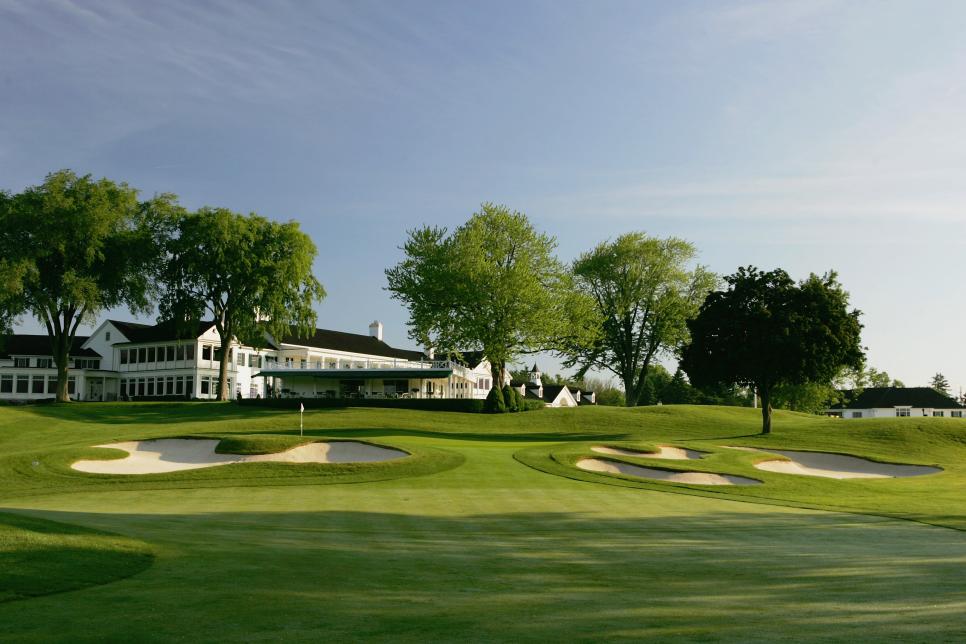U.S. Open 2024: USGA championship anchor sites are about far more than the golf – Australian Golf Digest

- by Admin
- June 10, 2024

Pinehurst Resort hosts its fourth U.S. Open this week on its No. 2 Course, and its first in 10 years, but going forward the iconic Donald Ross design is going to get a lot more traffic. Just five years hence, Pinehurst will host the U.S. Open and U.S. Women’s Open in consecutive weeks, reprising the 2014 double-header. U.S. Opens also return in 2035, ’41 and ’47.
Such devotion only seems logical with the establishment of the USGA’s satellite headquarters, Golf House Pinehurst, which officially opened last month and includes a research facility and new home to the World Golf Hall of Fame. But identifying Pinehurst as an anchor site is only of a piece with its long-range strategic planning for not only the U.S. Open but also many of its championships.
Oakmont Country Club, near Pittsburgh, which has hosted more U.S. Opens than any other venue, and Pebble Beach Golf Links in California, also have been given anchor designation, and will host four U.S. Opens apiece in the coming years as the USGA ties down its schedule almost completely through 2051. In fact, every U.S. Open is spoken for through 2042, with repeat engagements at historic venues such as Merion, Shinnecock Hills and Oakland Hills. The only available dates are 2043, ’45, ’46 and ’48.
The U.S. Women’s Open is spoken for through 2036, but the USGA has other dates mapped out, including Pebble Beach in 2048.
RELATED: Is the USGA going to punish players for going low in L.A. and Louisville? Not exactly
It’s all part of bringing a higher level of planning and commitment—and hopefully execution—to many USGA championships. And not just regarding its biggest events. To cite one example, the USGA and Oakland Hills, north of Detroit, struck an agreement in 2022 in which eight USGA events will be played on the historic venue, starting with this year’s U.S. Junior Amateur and ending in 2051 with the U.S. Open. In between will be six additional USGA championships, including two U.S. Women’s Opens, a U.S. Women’s Amateur, a U.S. Girls’ Junior and the U.S. Amateur.
Oakland Hills will host eight USGA championships in the future.
David Cannon
“This is about putting our stake in the ground and establishing a foundation, partnering with what we think of as the cathedrals of the game in America,” said John Bodenhamer, USGA chief championships officer. “It really comes down to continuous improvement and let’s say a little bit of familiarity, too.
“We’ve developed a cadence that allows us to go to what we think are the cathedrals and conduct our championships. They know we’re coming back. And so the venues, whether they’re anchor sites or not, they know we’re coming back, and they look to improve, whether it’s on the golf course, whether it’s in the clubhouse or acquiring additional property to make sure that a U.S. Open is viable.”
Bodenhamer said the strategy was formulated around a message put forth by three-time major champion Nick Price, who served on the USGA Executive Committee from 2018-2023. The former World No. 1 served on the championship committee within the Executive Committee, and a few years ago, he provided the organization with what is now the lynchpin to its philosophy.
“I was leading the meeting and Nick looked over at me and said, ‘John, it’s pretty simple. It’s important where players win their U.S. Open, be it men or women,’” Bodenhamer said. And there was this silence for about 15 or 20 seconds. Nobody quite knew what to say to that. It was so simple. Yeah, that makes sense. We’ve got to go here. We’ve got to go there. It’s where players want to win a U.S. Open.”

Shinnecock Hills is scheduled to host two upcoming U.S. Opens.
Dom Furore
“I just expressed an idea that I thought was obvious, at least to me and how I think about major championships,” Price said. “As a player, you want to win at Augusta. You want to win at St. Andrews or Pebble Beach or Oakmont. Credit to the USGA leadership for taking that idea and building a strategy around it to plan it out and prepare to play its championships at really special places, courses steeped in history as well as being great tests of golf.”
Feedback from players provided further impetus to start thinking long term. “They’ve shared with us how they think about it,” Bodenhamer said. “They all have their favorites. They all have where they want to win, but we know more about that. And so that was really the foundation. But I think really other than that, I think we just felt that we want to go to the game’s best venues.
“We’re building relationships. It’s nonstop now,” Bodenhamer added. “We’re able to look further ahead and do things with the community and the golf courses … with permitting and facilities and public safety, parking and transportation. Where when we were looking five, six, seven years out, or even beginning preparations two or three years out, we now look 10, 15 years out and we’re able to do things that we never contemplated before.”
RELATED: What would you shoot at a U.S. Open? Handy new tool settles debate
At this week’s U.S. Open, there are several notable new features that lean into that planning. Bodenhamer said the USGA and Pinehurst have buried thousands of feet of electrical lines under the No. 2 course and around it and added new water lines. Miles of additional roadways have been built “that no one will see,” he said, “to improve the fan experience, particularly with concessions.”
He added that, “We’ve placed at the top of the pyramid the player experience. We want to make sure that the players have the best experience in the game. We mean that and we invest in it. The clubs do too. For example, Pinehurst spent multiple millions of dollars redoing their locker room. It’s magnificent [with] physio areas, cold-plunge baths. There’s even a tunnel from the locker room up to the first tee. It’s remarkable.
“So it’s just kind of a momentum of everything to just continuously improve every time we’re back somewhere, whether it’s an anchor sites or the long-term relationships, and we’re excited about it.”
Future U.S. Open sites
- 2025: Oakmont Country Club – Oakmont, Pa. (June 12-15)
- 2026: Shinnecock Hills Golf Club – Southampton, N.Y. (June 18-21)
- 2027: Pebble Beach Golf Links – Pebble Beach, Calif. (June 17-20)
- 2028: Winged Foot Golf Club – Mamaroneck, N.Y. (June 15-18)
- 2029: Pinehurst Resort & C.C. (Course No. 2) – Village of Pinehurst, N.C. (June 14-17)
- 2030: Merion Golf Club – Ardmore, Pa. (June 13-16)
- 2031: Riviera Country Club- Pacific Palisades, Calif. (June 12-15)
- 2032: Pebble Beach Golf Links – Pebble Beach, Calif. (June 17-20)
- 2033: Oakmont Country Club – Oakmont, Pa. (June 16-19)
- 2034: Oakland Hills Country Club (South Course) – Bloomfield Hills, Mich. (June 15-18)
- 2035: Pinehurst Resort & C.C. (Course No. 2) – Village of Pinehurst, N.C. (June 14-17)
- 2036: Shinnecock Hills Golf Club – Southampton, N.Y. (TBD)
- 2037: Pebble Beach Golf Links – Pebble Beach, Calif. (TBD)
- 2038: The Country Club – Brookline, Mass. (TBD)
- 2039: The Los Angeles (Calif.) Country Club (North Course) (June 16-19)
- 2040: Merion Golf Club – Ardmore, Pa. (June 14-17)
- 2041: Pinehurst Resort & C.C. (Course No. 2) – Village of Pinehurst, N.C. (June 13-16)
- 2042: Oakmont Country Club – Oakmont, Pa. (June 12-15)
- 2043: TBD
- 2044: Pebble Beach Golf Links – Pebble Beach, Calif. (TBD)
- 2045-46: TBD
- 2047: Pinehurst Resort & C.C. (Course No. 2) – Village of Pinehurst, N.C. (TBD)
- 2048: TBD
- 2049: Oakmont Country Club – Oakmont, Pa. (June 17-20)
- 2050: Merion Golf Club – Ardmore, Pa. (June 16-19)
- 2051: Oakland Hills Country Club – Bloomfield Hills, Mich. (TBD)
This article was originally published on golfdigest.com
The Latest News
-
December 26, 2024Australian tennis suffers two worrying setbacks ahead of the 2025 Australian Open
-
December 26, 2024Heatwave sparks warning of potentially devastating wildfires in Australian state
-
December 26, 2024‘Fresh and ready to go’: Sabalenka hungry and ready for more grand slam success
-
December 26, 2024Andy Roddick says he has one big concern about Iga Swiatek heading into the Australian Open
-
December 26, 2024Thanasi Kokkinakis injury: News, updates as Australian tennis player withdraws from Brisbane International | Sporting News Australia





